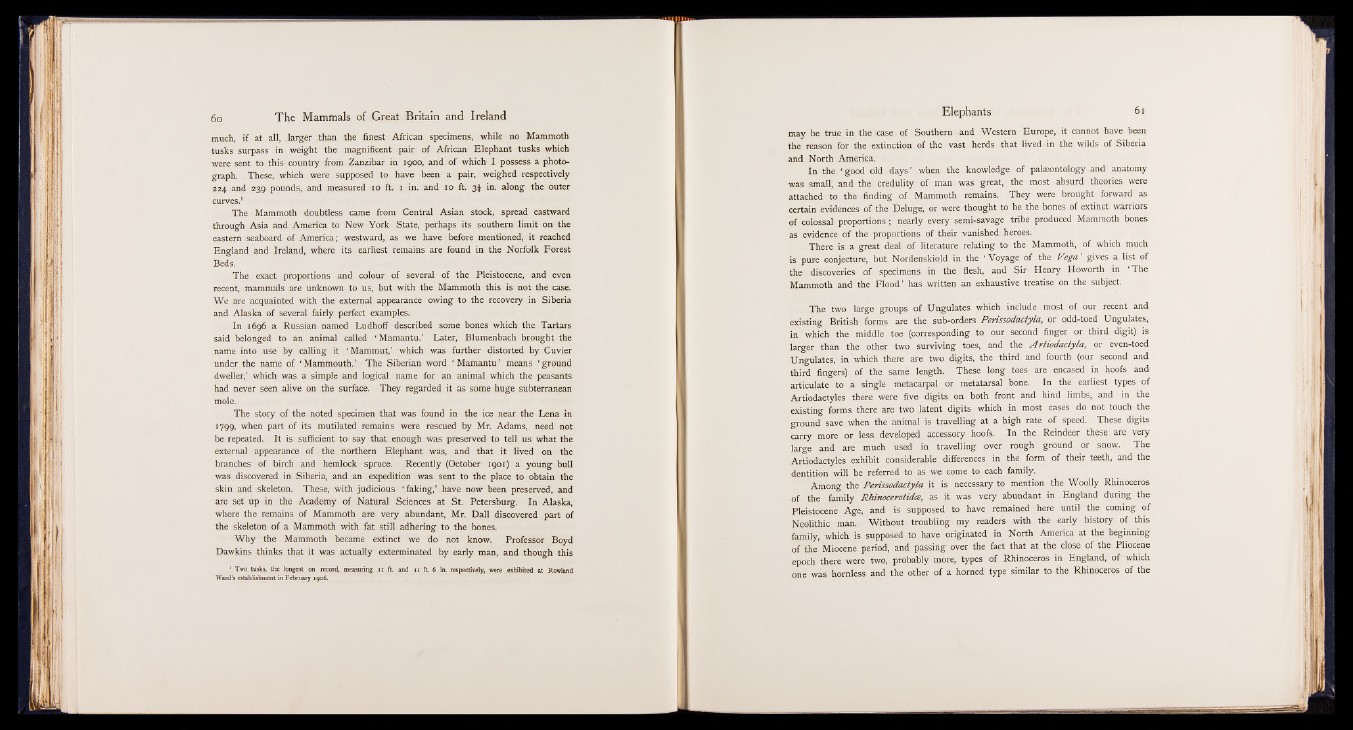
much, if at all, larger than the finest African specimens, while no Mammoth
tusks surpass in weight the magnificent pair of African Elephant tusks which
were sent to this country from Zanzibar in 1900, and of which I possess a photograph.
These, which were supposed to have been a pair, weighed respectively
224 and 239 pounds, and measured 10 ft. 1 in. and 10 ft. 3$ in. along the outer
curves.1
The Mammoth doubtless came from Central Asian stock, spread eastward
through Asia and America to New York State, perhaps its southern limit on the
eastern seaboard of America; westward, as we have before mentioned, it reached
England and Ireland, where its earliest remains are found in the Norfolk Forest
Beds.
The exact proportions and colour of several of the Pleistocene, and even
recent, mammals are unknown to us, but with the Mammoth this is not the case.
We are acquainted with the external appearance owing to the recovery in Siberia
and Alaska of several fairly perfect examples.
In 1696 a Russian named Ludhoff described some bones which the Tartars
said belonged to an animal called ‘ Mamantu.’ Later, Blumenbach brought the
name into use by calling it ‘ Mammut,’ which was further distorted by Cuvier
under, the name of ‘ Mammouth.’ The Siberian word ‘ Mamantu’ means ‘ ground
dweller,’ which was a simple and logical name for an animal which the peasants
had never seen alive on the surface. They regarded it as some huge subterranean
mole.
The story of the noted specimen that was found in the ice near the Lena in
1799, when part of its mutilated remains were rescued by Mr. Adams, need not
be repeated. It is sufficient to say that enough was preserved to tell us what the
external appearance of the northern Elephant was, and that it lived on the
branches of birch and hemlock spruce. Recently (October 1901) a young bull
was discovered in Siberia, and an expedition was sent to the place to obtain the
skin and skeleton. These, with judicious ‘ faking,’ have now been preserved, and
are set up in the Academy of Natural Sciences at St. Petersburg. In Alaska,
where the remains of Mammoth are very abundant, Mr. Dali discovered part of
the skeleton of a Mammoth with fat still adhering to the bones.
Why the Mammoth became extinct we do not know. Professor Boyd
Dawkins thinks that it was actually exterminated by early man, and though this
1 Two tusks, the longest on record, measuring n f t and n f t 6 in. respectively, were exhibited at Rowland
Ward’s establishment in February 1906.
may be true in the case of Southern and Western Europe, it cannot have been
the reason for the extinction of the vast herds that lived in the wilds of Siberia
and North America.
In the ‘ good old days’ when the knowledge of paleontology and anatomy
was small, and the credulity of man was great, the most absurd theories were
attached to the finding of Mammoth remains. They were brought forward as
certain evidences of the Deluge, or were thought to be the bones of extinct warriors
of colossal proportions ; nearly every semi-savage tribe produced Mammoth bones
as evidence of the proportions of their vanished heroes.
There is a great deal of literature relating to the Mammoth, of which much
is pure conjecture, but Nordenskiold in the ‘ Voyage of the Vega gives a list of
the discoveries of specimens in the flesh, and Sir Henry Howorth in ‘ The
Mammoth and the Flood ’ has written an exhaustive treatise on the subject.
The two large groups of Ungulates which include most of our recent and
existing British forms are the sub-orders Perissodactyla, or odd-toed Ungulates,
in which the middle toe (corresponding to our second finger or third digit) is
larger than the other two surviving toes, and the Artiodactyla, or even-toed
Ungulates, in which there are two digits, the third and fourth (our second and
third fingers) of the same length. These long toes are encased in hoofs and
articulate to a single metacarpal or metatarsal bone. In the earliest types of
Artiodactyles there were five digits on both front and hind limbs, and in the
existing forms there are two latent digits which in most cases do not touch the
ground save when the animal is travelling at a high rate of speed. These digits
carry more or less developed accessory hoofs._ In the Reindeer these are very
large and are much used in travelling over rough ground; or snow. The
Artiodactyles exhibit considerable differences in the form of their teeth, and the
dentition will be referred to as we come to each family.
Among the Perissodactyla it is necessary to mention the Woolly Rhinoceros
of the family Rhinocerotida, as it was very abundant in England during the
Pleistocene Age, and is supposed to have remained here until the coming of
Neolithic man. Without troubling my readers with the early history of this
family, which is Supposed to have originated in North America at the beginning
of the Miocene period, and passing over the fact that at the close of the Pliocene
epoch there were two, probably more, types of Rhinoceros in England, of which
one was hornless and the other of a horned type similar to the Rhinoceros of the